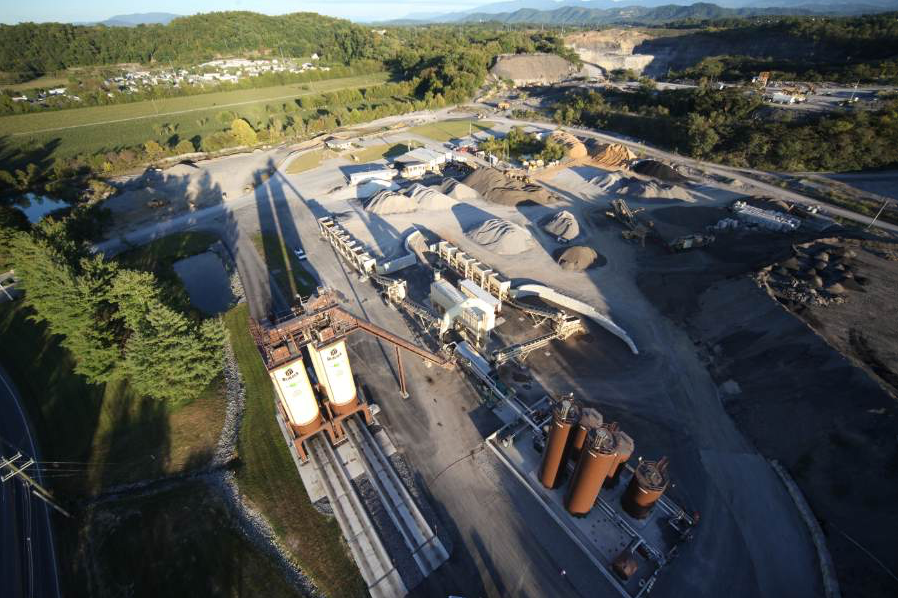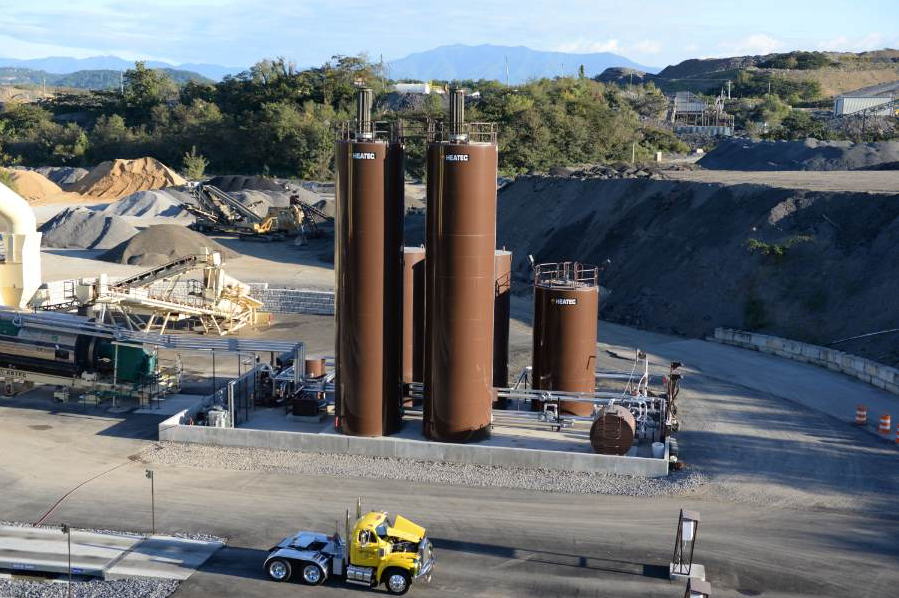Store Power Savings
BY Sandy Lender

You may know that Charlie Blalock and his sons formed a company called Charles Blalock & Sons, Inc., in 1963 in Sevier County, Tennessee. This past year, the company purchased an Astec Relocatable 400 TPH Double Barrel® plant for its Park Road location in Sevierville. What they’ve done falls under the category of smart asphalt planning and wise use of resources. Kevin Blalock, vice president of Charles Blalock & Sons, and William Smith, asphalt plant manager, shared some of the decisions they made for a lean and clean asphalt facility in the Great Smoky Mountains.
“We met with Don Brock and discussed the plant features and options that would be best for our location to meet environmental standards,” Blalock said. “We aim to be good environmental stewards across all platforms of our business, from construction to plant design to utilizing recycled materials.”
The new asphalt plant features a natural gas-fired Astec Phoenix Talon ultra-low NOx burner, three RAP feeder bins, a shingle feeder bin, and grid power to minimize its environmental footprint while increasing output. One of the clever ways the plant team watches its power use is through the four-silo configuration of New Generation storage silos.

“We supply a majority of the asphalt on the Tennessee side of the Great Smoky Mountains National Park,” Blalock said. “Having the ability to store mixes maximizes the availability to provide materials to our customers on demand.”
Smith shared that the four 300-ton silos will hold up to 1,200 tons of material for an extended period of time. Malcolm Swanson of Astec said four days of storage is what’s guaranteed by Astec. At first, that concept made Smith as nervous as it would any other veteran plant manager. Think about it: 600 or 900 tons of asphalt mix sitting in silos overnight and then all day the next day and then overnight again and then all day again. This is starting to sound like a Halloween story, isn’t it? Never fear: there’s a way to make this a happily ever after.
Smith said that when they met with the team from Astec, he told them, “The first time I can’t get the mix out, they can come dig it out.” They assured him with the same science Swanson told us about.
Producers often think of silo insulation keeping heat in as the No.1 way to keep material stored safely. Think also of what the silo needs to keep out.
“Heat containment is obviously important, but is secondary to prevention of air leakage,” Swanson said. “The discharge gate employs an oil seal. The gate has in it a reservoir into which oil is pumped from a tank, usually mounted on the silo leg structure, when the operator has material in the silo that he wants to store for some time. The oil in the gate reservoir submerges the lower lip of the silo discharge completely sealing off any possible inward air leakage. This prevents oxygen from entering and prevents oxidation of the liquid asphalt on the mix. The mix remains fresh and usable for as much as several days….Even very small leaks will cause oxidation, which will cause the mix to harden in the silo. That leads immediately to a bad day.”
Smith said they’ve stored mix for up to three days and the material has come out of the silos with no trouble. This comes in handy for days when a project gets interrupted by weather, of course, but it presents the opportunity to save on operating and utility costs.
“If I’ve got the mix dialed in properly, it can go and fill up the silos; we’re not making mix and worrying about something going out at night.” He stated that the continuous production eliminates the repeated wasted mix at repeated start-ups. When the plant team is able to produce one type of mix continuously until the silo(s) are full, it saves on time and overtime. He explained that the plant personnel might not have to come in as early on the second or third day of a project if the silos are filled up and ready to go.
The technical book “Astec T126” shows survey results that approximately 95 percent of plant breakdowns occur at start-up in the morning. The text points out: “With only a surge bin, no mix would be in the bin, and all the trucks, paving crews, etc., would be backed up and stopped. With 400 to 600 tons of storage, the first rounds of trucks can be sent to the paving crew and paving can proceed with no delays in the trucks or paving crews.” Consider also the benefits of filling silos on Friday to sell to local customers on Saturday without having to pay overtime to the full plant crew complement.
One of the biggest savings for Blalock comes in the form of lowering peak demand with the utility company. By operating the plant when power charges are at their lowest, rather than firing up on a moment’s notice when peak demand could mean peak electric prices, Blalock & Sons is realizing significant savings.
Heatec, Inc., provided a number of components for the facility, which runs on natural gas. Those components include: unloading pump; horizontal additive tank; vertical 15,000-gallon emulsion tank; two 35,000-gallon vertical asphalt tanks with vent condensers; two 20,000-gallon vertical fuel tanks; one 1,000-gallon calibration tank; one 2-million BTU/hour hot oil heater; and a twin pump metering system.
The Heatec heater provides hot oil to heat everything in the plant. By burning natural gas, fewer emissions are produced than would be produced with other fuels such as diesel and waste oil. In addition, the heater is equipped with a StackPack™ economizer. The StackPack boosts the overall efficiency of the heater, which means Blalock burns less fuel and creates even less emissions.
Prior to the New Generation storage system, Charles Blalock & Sons had not used long-term storage for its mixes. The adjustment meant learning new skills for productivity.
“Our operators had to learn to put the mix in at the right temperature,” Blalock said. “Once we overcame the learning curve, the storage of our mixes has been fantastic….We have consistently stored mix for up to three days knowing the silos could store up to four days.”
Smith added: “We’ve sent operators and other staff, including myself, to Astec’s Advanced Customer Schools to increase our knowledge and hands-on ability to make our plant as efficient as possible.” Smith shared that the Park Road plant operator, Ryan Helton, has been with the company since about 2010 and runs the system very well. As Swanson shared, one of the tricks is to watch the temperature.
“People tend to worry too much about keeping the mix hot,” Swanson warned. He explained that sometimes an operator will make the asphalt mix a little hotter when he knows he’ll be storing it overnight or for a couple of days. “That is the wrong thing to do because elevated temperature increases oxidation. We do provide a heavy layer of insulation, and we typically use electric ‘blankets’ to keep at least the cone hot. Heat is provided for the spool of the silo too, as an option.”
In the event that mix sits too long, Smith said he has seen some stiffening of the mix. He said that can be attributed to the amount of recycled asphalt pavement (RAP) content and isn’t necessarily a problem.
“If you’re laying it out on a long pull without a lot of handwork, the stiffness doesn’t matter a lot,” he said.
According to Blalock, the Double Barrel is running RAP for various projects. Smith explained that TDOT’s top courses limit RAP to 15 percent. At this time, with liquid AC prices lower than recent years, the use of RAP has been less vital as an economic choice, but the plant is equipped to run up to 50 percent RAP mixes. Blalock said that’s the percentage used in the mix for the company’s parking lot.
Smith shared a few of the other energy saving features of the plant. “Other notable features include the variable speed motors, which have been a great benefit to us—not just on energy savings, but helping us control heat and production. We have the self cleaning system on the Double Barrel drum mixer and it all but eliminates the buildup.”
